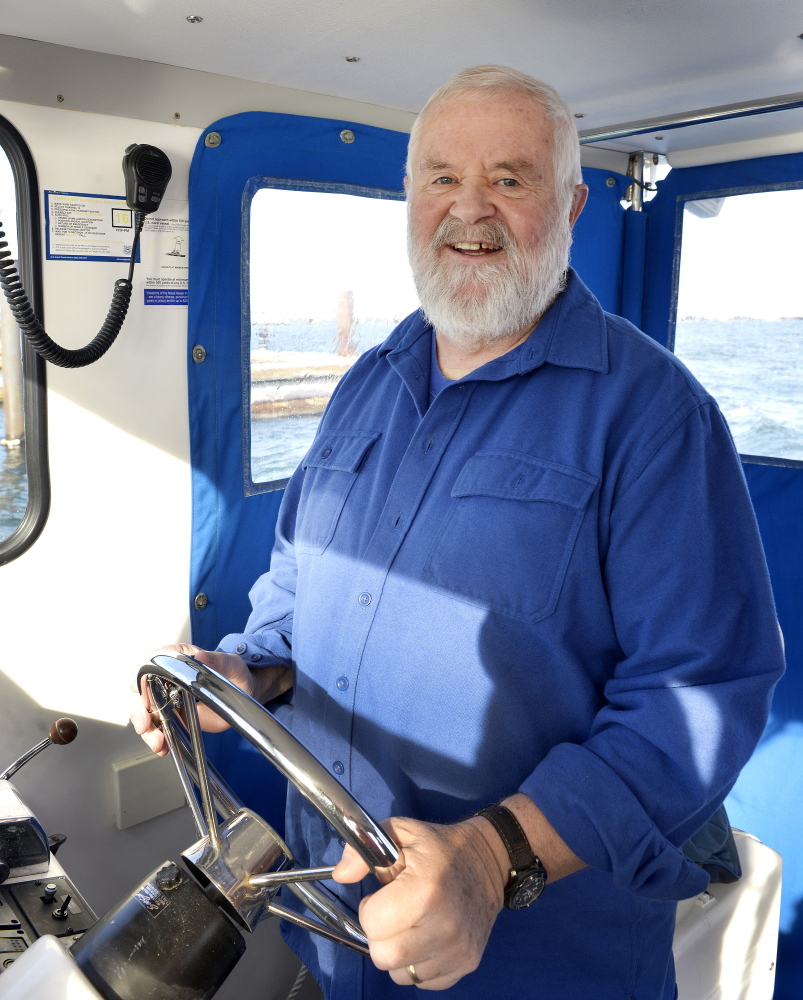Never did Joe Payne imagine, less than an hour into his first day on the job 24 years ago, that he’d be talking about pumpkins.
It was Aug. 19, 1991. While Hurricane Bob thrashed New England, an Associated Press reporter called to ask Casco Bay’s newly anointed baykeeper what effect the massive storm might have on the coastal basin of seawater stretching from Cape Elizabeth to Cape Small.
Payne’s first response, having served as one of the nation’s first waterkeepers for exactly 37 minutes: “For crying out loud! My chair isn’t even warm!”
But then he thought about it for a second. And so began what would become almost a quarter-century of public enlightenment.
“I think the hurricane is giving people a vivid picture of how much stuff comes down the Presumpscot River into Casco Bay,” Payne told the reporter. “Because what’s coming down the river right now are pumpkins.”
He wasn’t kidding. The hurricane had flooded countless inland gardens and farms brimming with bright-orange pumpkins, many of which had come untethered and floated down the rivulets, into the streams and eventually out onto the river as it roared its way toward Casco Bay.
Advised Payne, “If you can picture a pumpkin, then maybe you can picture a particle of manure.”
It was but one in a sea of memories that washed over Payne on Friday as he took a meandering, valedictory boat ride around the bay that’s been in his blood since, well, forever. Come Jan. 9, Payne, 67, will retire as baykeeper for Friends of Casco Bay – the watchdogs for an estuary that has evolved from an open sewer in the 1970s to a crown jewel in Maine’s coastal economy today.
“My first trips on this bay were in utero,” Payne said with a chuckle, explaining how his pregnant mother made many a trip between the family home on Danforth Street in Portland and a modest summer cottage on Peaks Island that remains in the family to this day. “So you can say this is in my blood.”
Not to mention his soul.
Payne, then 43, was working in New Hampshire with the marine consulting firm Normandeau Associates back in 1991 when he came across an ad in the Maine Times seeking a baykeeper for the then-fledgling Friends of Casco Bay. He hadn’t a clue what a baykeeper was, but when his wife, Kim, told him the job had his name written all over it, he took a deep breath and hand-delivered his resume along with 70 others who liked the sound of the title.
It was meant to be. And Payne, as he’s proven over and over since, turned out to be the perfect guy for the job.
Many of his peers – from only seven in the country when he began, the number of waterkeepers has grown to more than 240 worldwide – typically have relied on lawsuits and headline-grabbing media events to clean up their waterways. Not Payne.
“I’ve always been able to do that in-your-face advocacy behind closed doors,” he said. “Sometimes with 20 people, sometimes with one person.”
His typical greeting upon showing up, sans attorneys or media horde, to call out a polluter on this illegal discharge of fish-processing waste or that emission of raw sewage: “You’re lucky it’s just me.”
It’s worked – to a point.
Without question, Payne said, Casco Bay is cleaner than it was when he first sat down that August day in a borrowed chair at a borrowed desk in borrowed office space on Commercial Street in Portland.
For example, where once only one Casco Bay marina provided a sewage pump-out station (as required by law at the time) for recreational vessels, 23 marinas up and down the bay now offer the service – along with a pump-out boat owned and operated by Friends of Casco Bay that charges boaters only $10 to responsibly empty their heads.
Where once the waterfront was awash in combined sewage overflows – the confluence of storm water and raw sewage that occurs whenever heavy rain overwhelms municipal sewage treatment plants – the number of so-called CSOs is now at least on the decline.
South Portland, Payne said, has gone from 19 CSO sites when he first arrived to only five today.
Portland, meanwhile, has committed $240 million over the past six years to further separate its sewage from its storm water.
Where once testing of Casco Bay’s water and sediment was at best a hit-or-miss affair, Payne has established a nationally renowned, year-round monitoring program that includes not only two full-time staffers from Friends of Casco Bay (which now boasts a total staff of eight), but hundreds of volunteers who test the water religiously up and down the bay during the warmer months.
And what does that data show?
Less sewage and other visible pollution, to be sure.
But at the same time, warns Payne, a troubling uptick in the bay’s nitrogen levels is fast depleting oxygen levels while increasing the acidity of the water and sediment.
That, in turn, means an increasingly stressed ecosystem, perhaps best illustrated by the expanding patches of “dead mud” where once there were productive and profitable clam flats.
“I have never been a Chicken Little. I’m pragmatic about the way I approach doing this,” Payne said as Falmouth’s seemingly pristine shoreline passed by. “But lately I’ve taken to saying nitrogen is going to be the death of us.”
It’s a hard warning to sound, especially when compared to, say, the disaster of 1996, when the tanker Julie N hit the Casco Bay Bridge and spewed close to 180,000 gallons of petroleum into Portland’s inner harbor. Payne, who beat even the Coast Guard to the scene that awful day, went on to play a pivotal role in what became a global model for cleaning up a major spill quickly, thoroughly and with virtually no lasting environmental damage.
The smell of that oil, even more than the sight of it, heightened all of Maine’s awareness of the fragility of the bay, recalled Payne. Yet many of those same folks now spread fertilizer on their lawns each summer without realizing that all that nitrogen is a bigger threat to the bay’s long-term health than the Julie N ever was.
Enter Payne’s BayScaping program, a far-reaching effort to teach coastal and inland homeowners alike that they can build healthy, attractive turf without resorting to Turf Builder or some other chemical concoction.
“I also say to people, ‘Love a dandelion!’ ” he said. “If my lawn were to turn yellow, I’d love it.”
Payne will miss the hundreds, make that thousands, of Mainers who have come to know him these past 24 years not only as a tireless advocate for Maine’s highest-profile body of water, but also as a guy who’s more interested in getting results than in simply stirring the pot.
But he’ll equally miss working on what went from his childhood playground to his grown-up office. You can’t spend every childhood summer on Peaks Island and not fall in love with the water that surrounds it.
Looking out at the all-but-empty bay from the wheelhouse of the new 28-foot research boat that aptly bears his name, Payne mused, “People ask me when my favorite time out on the bay is and I tell them it’s February.”
Why so?
“Coming up Broad Cove (off Falmouth Foreside), you’ll see all the bergies, or icebergs, coming down,” he said wistfully. “And each one has a seal on it. Or one time, I saw an eagle with a fish, just sitting there on a bergie, floating by.”
You’ve got to wonder if those critters knew, as he stared at them and they back at him, that this was no average Joe coming out to visit in the dead of winter.
This was the one and only Joe Payne. The keeper of their bay.
Send questions/comments to the editors.




